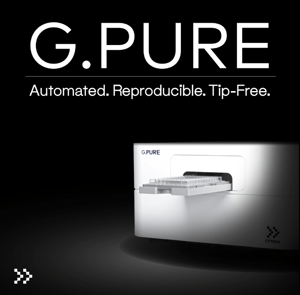A liquid handler is a laboratory instrument that automates the process of dispensing and mixing small volumes of liquid. It is used to accurately and efficiently dispense reagents and samples into various types of containers, such as microliter plates, tubes, or wells. A plate washer is a laboratory instrument that automates the process of washing and rinsing microtiter plates.
Both liquid handlers and plate washers are commonly used in the laboratory to increase efficiency, reduce errors and improve reproducibility of experiments.

Efficiency
Liquid handlers, such as the I.DOT Liquid Handler, and plate washers, such as the G.PURE NGS Clean-Up Device, can perform repetitive tasks quickly and accurately, which increases the efficiency of the laboratory. For example, liquid handlers can rapidly dispense precise volumes of reagents into a large number of wells on a micro liter plate, while plate washers can quickly wash and rinse the plates, which can be time-consuming and tedious when done manually.
Reducing Errors
Liquid handlers and plate washers reduce the risk of human error by automating the process. Manual dispensing and washing can be prone to errors such as over- or under-dispensing, cross-contamination, or inconsistent washing. Automated liquid handlers and plate washers can reduce these errors and increase the reliability of the experiment.
Reproducibility
Liquid handlers and plate washers can increase the reproducibility of experiments by ensuring that the same protocols are followed consistently. The instruments can be programmed to dispense or wash the plates according to specific protocols, which reduces the chance of variation between experiments.
High-Throughput
Liquid handlers and plate washers are particularly useful for high-throughput experiments, such as drug screening or genotyping, where many samples need to be processed in a short amount of time.
Handling large number of samples
Liquid handlers and plate washers are ideal for handling large numbers of samples in parallel, which is useful for applications such as gene expression profiling, where many samples need to be analyzed simultaneously.
Handling small volumes
Liquid handlers are particularly useful for handling small volumes of liquid, which is important in applications such as PCR and ELISA where small volumes of reagents are needed.

Washing
Plate washers, such as the G.PURE, are particularly useful for washing and rinsing plates, which is important for applications such as ELISA and cell-based assays where the plates need to be washed multiple times before the assay is performed.
Compatibility
Liquid handlers and plate washers are compatible with a wide range of labware, such as multiwell plates, tubes, and vials.
Versatility
Liquid handlers and plate washers are versatile instruments that can be used for a wide range of applications, such as PCR, ELISA, cell-based assays, and high-throughput screening.
Overall, liquid handlers and plate washers are essential laboratory instruments that increase efficiency, reduce errors, and improve reproducibility of experiments. They are particularly useful for high-throughput experiments, handling large numbers of samples, handling small volumes, washing and rinsing microtiter plates, and are compatible with a wide range of labware.
Read about the I.DOT Non-Contact Dispenser and G.PURE NGS Clean-Up Device to learn how to use this great tool to automate your lab today.
Have some detailed questions? Speak with a sales rep or request a quote and we will be happy to help you create the future of health.